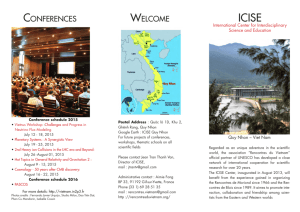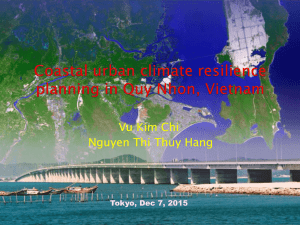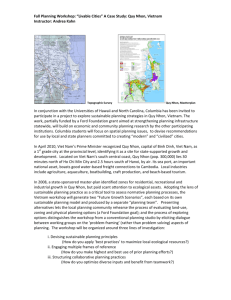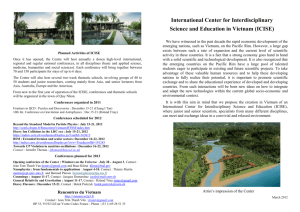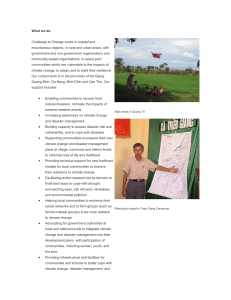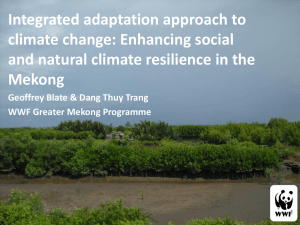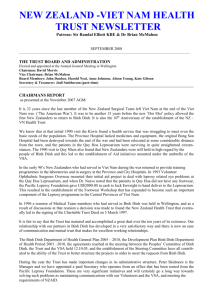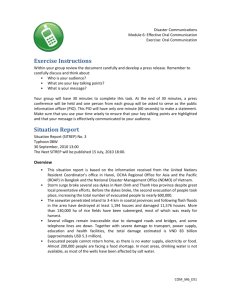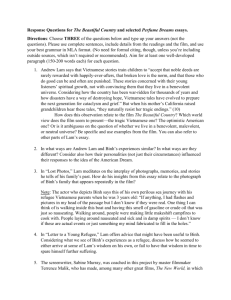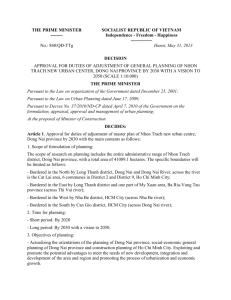1 Basi 1.1 Geog Binh the East (Nationa sea for th
advertisement
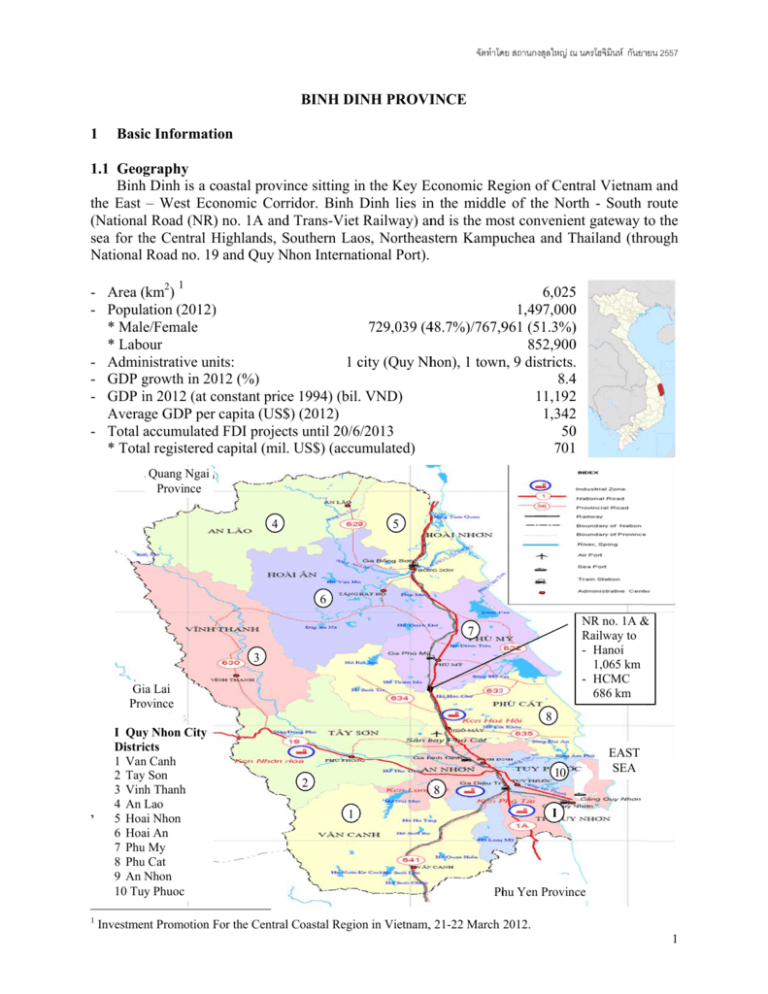
จัดทําโดดย สถานกงสุลใหญ ณ นครโฮจิมินห กันยาายน 2557 BINH DIINH PROVIINCE 1 Basiic Informatiion graphy 1.1 Geog Binh h Dinh is a coastal c province sitting in n the Key E Economic Reegion of Cenntral Vietnam m and the East – West Eco onomic Corrridor. Binh Dinh lies inn the middlee of the Norrth - South route (National Road (NR)) no. 1A and d Trans-Viett Railway) annd is the moost conveniennt gateway tto the sea for th he Central Highlands, H Southern S Lao os, Northeasstern Kampuuchea and T Thailand (thrrough National Road no. 19 9 and Quy Nhon N Internattional Port). 1 - Area (km ( 2) 6,0255 - Populaation (2012)) 1,497,0000 * Male/Female 729,039 (448.7%)/767,9961 (51.3%)) * Labo our 852,9000 - Admin nistrative un nits: 1 city c (Quy Nhhon), 1 townn, 9 districts.. - GDP growth g in 20 012 (%) 8.44 - GDP in i 2012 (at constant c price 1994) (bil. VND) 11,1922 Averaage GDP per capita (US$ $) (2012) 1,3422 - Total accumulated d FDI projeccts until 20/6 6/2013 500 umulated) 7011 * Totaal registered capital (mil. US$) (accu Quang Ngai Province 4 5 6 NR no. 1A & Railway to - Hanoi 1,065 km - HCMC 686 km 7 3 Giia Lai Pro ovince , 1 I Quy y Nhon City Distriicts 1 Van n Canh 2 Tay y Son 3 Vin nh Thanh 4 An Lao 5 Hoaai Nhon 6 Hoaai An 7 Phu u My 8 Phu u Cat 9 An Nhon uy Phuoc 10 Tu 8 10 2 EAST SEA 8 1 I Phhu Yen Provinnce Investment Promotion For F the Centrall Coastal Regio on in Vietnam,, 21-22 March 2012. 1 จัดทําโดย สถานกงสุลใหญ ณ นครโฮจิมินห กันยายน 2557 - Export turnover (mil. US$, 2012) 521.6 (furniture, agricultural and forestry products, seafood, mineral products, granite stone, titanium, garment, footwear, pharma-ceutical products, handicraft, etc.) - Import turnover (mil. US$, 2012) 181 (Wood and raw materials for producing consumer goods and goods for export, machinery and equipment, etc.) Binh Dinh is 1,065 km from Hanoi and 686 km from Ho Chi Minh City (HCMC). The provincial territory stretches 110 km in the north – south direction, with an average width of 55 km (the narrowest and widest sections are respectively 50 km and 60 km). Binh Dinh borders 63 km with Quang Ngai Province to the north, 50 km with Phu Yen Province to the south, 130 km with Gia Lai Province to the west. The province fronts the East Sea with a 134-km coastline to the east and includes both small and large offshore islands. The traffic network comprises road, railway, waterway, and airway. The average daily volume of traffic is about 2,500 – 2,700 vehicles. National Road (NR) no. 19 links Quy Nhon International Sea Port with Duc Co, Bo Y International Border Gate and the three-border zone of Vietnam, Kampuchea, and Laos. This is the best road in the horozintal axis of the central Vietnam, creating conditions of economic linkage between the east and the west and promoting outward economic cooperation. Binh Dinh is expanding cooperation with the Lao’s provinces of Champasak, Sekong, Attapu, Salasan, and Thailand’s provinces of Sisaket and Ubon Rathchathani. Crossing Binh Dinh Province (km) NR no. 1A 118 NR no. 1D 20.7 NR no. 19 69.5 Binh Dinh was probably one of the places where the Cham first arrived in what is now Vietnam. Its favourable geography led to the rise of the Cham Port of Thi Nai where Quy Nhon is now located. The city-state of Vijaya was located around this port and the main city, which was further inland. Its centre was in the southern lowland of Bình Định. However, its architecture implies that it did not become important until the eleventh or twelfth century. 2 1.2 Population 3 (Please see Annex 1: Population of Binh Dinh Province, 1995, 2000-2011, page 18) The population of Binh Dinh in 2012 is 1,470,000, making it the most populous province of the South Central Coast, of which the people of working age accounts for over 55%. It has been growing slowly from 2000 to 2007 - at just 0.92% per year on average. However, the provincial population is in the tendency of mechanical decrease because according to the Population Census on 1/4/2009, the population number decreased to 1,485,943. As of 2010, 27.8% of the population live in urban areas, up from 19% in 1995 and 24.2% in 2000. More than 40% of the population settle in Quy Nhon City and two suburban districts of An Nhon and Tuy Phuoc. There is another relatively large concentration in the northern Hoai Nhon District with a population of 206,700 (2009) and a population density of 499/km2. Population density in the rest of the province ranges from 30 to 40 in districts of Van Canh, An Lao, and Vinh Thanh to 982 in Quy Nhon City. 2 3 http://en.wikipedia.org/wiki/Binh_Dinh_Province http://vi.wikipedia.org/wiki/Bình_Định 2 จัดทําโดดย สถานกงสุลใหญ ณ นครโฮจิมินห กันยาายน 2557 The eastern low wlands and Tay T Son Disstrict are larggely ethnicaally homogeeneous. Therre are about 250,000 peoplle of ethnic minorities living in 1133 villages/222 communess of mountainous and midlland area. They T comprisse Ba Na peeople in the sparsely poopulated disttricts of An Lao, Vinh Thaanh, and Van n Canh, som me H're peoplle live in Ann Lao and soome Cham inn Van Canh. Hoai An’s pop pulation is mostly m Kinh, but there arre some rem mote communnes that are dominated bby Ba Na and H're H people. ministration 1.3 Adm Quy y Nhon, the provincial p caapital, is a category c II c ity. There arre 10 districcts (An Lao, Hoai An, Hoaii Nhon, Phu My, Phu Caat, Vinh Thaanh, Tay Sonn, Van Canhh, An Nhon, Tuy Phuoc)), 157 villages, wards and to ownships in the province. Provinciial People’s Committeee (since 2011 1) 4 + Chairrman Mr. Le Huu Locc - Nativ ve village on Trach Commune, An Nhon Distriict, Nho Binh Dinh Prov vince - Date of birth 16/1 10/1954 - Education Bacchelor of Eco onomics - Curreent position Vice Secretary of o the Provinncial Party C Committee Chaairman of thee the Provinccial People’ss Committeee Mem mber of the Provincial P P People’s Couuncil, term 2011-2016 - Party y admission date d 17/3 3/1978 - Officcial admissio ond ate 27/9 9/1979 r Service record - 1975-9/1982 - 9/198 82-7/1983 8/198 83-12/1987 - 987-12/1990 0 12/19 - 990-3/1991 12/19 - 4/199 91-12/1998 - 12/19 998-3/2001 4/200 01-6/2004 - 04-12/2006 6/200 - 10/20010 – presennt Working at the Propagandaa and Traininng Board, Paarty Committtee of An A Nhon Disstrict Stud dying at the Central Proppaganda andd Training noo. 2, Da Nanng Vice Director of the Foreignn Trade Com mpany, An N Nhon Districct vince Binh Dinh Prov Direector of the General G Com mmodities C Company, Ann Nhon Distrrict Binh Dinh Prov vince G Buyying and Selling Servicee Company Direector of the General An Nhon District, Binh Dinnh Province Mem mber of the District D Stannding Party C Committee Vice Chairman of the Peoplle’s Committttee of An N Nhon Districct Binh Dinh Vice Chief of Cabinet, C Binhh Dinh Proviincial Party Committee Mem mber of Prov vincial Partyy Committeee Chief of Cabineet, Binh Dinhh Provinciall Party Comm mittee mber of the provincial p S Standing Partty Committeee Mem Vice Chairman of Binh Dinnh Provincial People’s C Comittee Vice Secretary of o Provinciaal Party Com mmittee Chaairman of thee Provincial People’s Coommittee 4 http://www w.chinhphu.vn//portal/page/po ortal/chinhphu//cactinhvathanhhpho/tinhbinhddinh/lanhdaotinnhthanh?personnProfi leId=1376& &govOrgId=13 337 3 จัดทําโดดย สถานกงสุลใหญ ณ นครโฮจิมินห กันยาายน 2557 + Vice Chairman Ho Quoc Q Dung Vice Chairman Maii Thanh Thang Vicee Chairpersoon Trann Thi Thu H Ha vincial Party y Committee + Prov Mr. Nguyen Vaan Thien - Secreetary ography and d climate 5 Topo The topography t is i relatively complex, lo owering from m the west too east. Elevaations range from 0 at the coast to aro ound 1,200 m above seea level in A An Lao Disstrict in the north-west. The m s edge of thee South Truoong Son Rannge, adjoinedd by the low wland, provinciaal west is a mountainous and then n the coast. While W most of the mou untains as weell as the hiighest peakss are in the west, there are mountains throughout t th he province,, even near tthe coast. Maain topograpphy comprisees: 2 Moun ntainous terrrain at an av verage elevattion of 500 – 1,000 m sllopes down over 20o, wiith an area of o about 249 9,866 ha, disstributing in districts of A Lao (63,3367 ha), Vinnh Thanh (788,249 ha), Van V Canh (7 75,932 ha), Tay Son, an nd Hoai An (31,000 ha)). Rivers andd streams haaving steep slopes origiinate in this area. This teerrain accounnts for 70% of the provinncial area. Hilly y area borderrs mountainous terrain to t the west and plain too the east, hhaving an arrea of aboutt 159,276 haa (accountin ng for 10% of the total provincial aarea) and ann elevation uunder 100 m and a slope from 10° - 15°. This teerrain is disttributed in diistricts of Hooai Nhon (155,089 ha), An A Lao (5,05 58 ha), and Van V Canh (7 7,924 ha). Lowlland area co omprises sm mall plains of o 1,000 km m2, formed by topograaphy and cliimate factorrs. The plain ns stretch alo ong tributariies of rivers or along thee coastline aare separatedd with sea by b lagoons, sandy hills, or mountaiin chain. Thhe largest loowland area is located iin the lowerr of Con Riiver, encom mpassing much of Quy Nhon City, districts off Tuy Phuocc, An Nhon n, the westerrn part of Phu u Cat Districct, and the eeastern part oof Tay Son D District. Given its size and a the acceess to a majo or port as well w as Binh Dinh's majoor river, it hhas long beeen the placee where mostt of Binh Din nh's people and a econom mic activities concentrate. Coasttal area com mprises sand ridges and dunes, d forminng a narrow w strip along the coast wiith an averaage width off 2 km. Larg ge sand ridg ges stretch frrom Ha Ra tto Tan Phunng and Vinhh Loi, from De Gi to Taan Thang, an nd from Trun ng Luong to Ly Hung. T There are maany lagoons aalong the coast, namely y, Thi Nai, Tra O, My Khanh, etc. and bays (L Lang Mai, Q Quy Nhon, V Vung Moi, etc.) and em mbouchures (An ( Du, Ha Ra, De Gi, aand Quy Nhoon.) Moun ntains form natural bord ders to the neighbouring n g provinces. Cu Mong Pass is the main border crrossing to Ph hu Yen Prov vince. NR no o. 1A passess through thiis pass, while there is annother road (no.. 1D) along the t coast. Th he border to Gia Lai Proovince is thee most mounntainous, witth the only road d connection n at An Khee Pass betweeen the townns of Phu Phhong in Tay Son Districct and An Khe in i Gia Lai Province. P Thee border to Quang Q Ngai Province is also very m mountainous,, with the majorr road and raailway passin ng through Binh B De Passs near Tam Quan. 5 http://vi.w wikipedia.org/w wiki/Bình_Địn nh 4 จัดทําโดย สถานกงสุลใหญ ณ นครโฮจิมินห กันยายน 2557 Climate The tropical monsoon dominates the area. Due to complex topography, monsoons change direction and intensity considerably when they land in the province. The total sunny hours per year is 2,354. The raining season starts from September until December and is accompanied by storms and floods. There is a secondary rainfall from May to August in mountainous area due to affects from the Central Highland’s rains. The dry season lasts from January to August and is accompanied by widespread droughts. The total rainfall tends to drecrease from the mountainous to coastal areas and from the northwest to southeast. The average temperature is 27oC and the average humidity is 80%. Storms frequently hit the Central Coastal Region including Binh Dinh Province, increasing their frequency from September to November. The coast from Quang Nam to Khanh Hoa is struck by an average of 1.04 storm a year. Average temperature (°C) Highest temperature (°C) Lowest temperature (°C) Average absolute humidity (%) Average relative humidity (%) Average rainfall (mm.) 3 Mountainous area 20,1 - 26,1 31,7 16,5 22,5 - 27,9 79-92 2,000 – 2,400 Coastal area 27 39,9 15,8 27,9 79 1,751 Resources 6 3.1 Land resources Under the effects of natural conditions and production, the soil has a general feature of good drainage, having light mechanical compositions, acid property, and poor in nutrients. There are 2 soil groups with 30 different types. The alluvial soil covers 71,000 ha, distributing along river basins. This is the best soil group for food crop and short-term industrial crop planting. The unused land accounts for 34% of the provincial total area. The agricultural land is 131,146 ha, categorised as follows in 2012 Land type Annual crops Paddy Area (ha) 99,228 53,247 Grass for husbandry 36 Other annual crops 45,945 Perennial Perennial Fruit crops industrial trees trees 31,918 25,534 2,553 Other perennial crops 3,831 3.2 Water resources + Sea Binh Dinh has a coastline of 134 km, territorial waters of about 2,500 km2, and more than 40,000 km2 of exclusive economic zone with various fishery resources. High value marine life conductive to fishing and farming comprises mackerels, tunas, shrimps, squids, swallow bird’s nests, lobsters, king crabs, etc. The total area of natural brackish water surface is 7,600 ha, including 5,060 ha of the Thi Nai Lagoon, 1,600 ha of the De Gi Lagoon, and 400 ha of the estuary in Tam Quan District. There are thousands hectares of salinized land and coastal sandy strips suitable for aquaculture development with high value products such as tiger prawn, white prawn, grouper, red snapper, cockle, oyster, crab, and gracilaria. 6 Investing in Binh Dinh, Investment Promotion Center of Binh Dinh Province. 5 จัดทําโดย สถานกงสุลใหญ ณ นครโฮจิมินห กันยายน 2557 + Rivers The provincial rivers originate from high mountainous areas in the east of the Truon Son Range. They are not large but steep and short. The alluvium content is low with a water reserve of 5.2 billion m3 for a potential hydropower of 182.4 million kW. Binh Dinh Province is endowed with large rivers such as Con, Lai Giang, La Tinh, Ha Thanh and a network of creeks and streams easily amenable to irrigation works, hydro-power development and fresh water for household consumption. + Lakes and ponds There are many artificial lakes in Binh Dinh to serve irrigation during the dry season. They comprise Hung Long Lake (An Lao District), Van Hoi Lake in My Du and Thach Khe (Hoai An District), My Binh Lake (Hoai Nhon District), Hoi Son and My Thuan Lake (Phu Cat District), Diem Tieu Lake, Hoc Nhan Lake, Phu Ha Lake (Phu My District), Dinh Binh Lake, Thuan Ninh Lake (Tay Son District), etc. In addition, there is a relatively large fresh water lagoon named Tra O in Phu My District and two brackish water lagoons De Gi (Phu My – Phu Cat districts) and Thi Nai (Tuy Phuoc, Quy Nhon City). The network of lakes and ponds create favorable conditions for agriculture development and aquatic farming. It is very convenient to develop sea port of national scale in Thi Nai Lagoon for Nhon Hoi Economic Zone.7 The total area of fresh water surface is 5,176 ha including natural and lagoons, low paddy fields, dams, and reservoirs of which the largest, Chau Truc Lagoon, is 1,200 ha. The largest lake is Dinh Binh Lake, an artificial lake mainly used for irrigation in the highlands of western Binh Dinh. Also in western Binh Dinh is Vinh Son Lake at Vinh Son Hydropower Station. Other major lakes include Nui Mot Lake in the south and Hoi Son Lake in the centre of the province. The Con River is the largest and most important river, forming a small delta north of Quy Nhon. These water surfaces are suitable for the development of fresh water farming such as tortoise, turtle, black eel, giant freshwater shrimp (Macrobrachium rosenbergii) and can be used as an inland waterway for transport. Other rivers are Lai Giang at the centre of the lowland areas of Hoai Nhon and Hoai An in northern Binh Dinh, My Cat in central Binh Dinh, and Ha Thanh along the valley in Van Canh District in southern Binh Dinh. 3.3 Mineral resources There are 18 kinds of raw materials and several hot springs and mineral water sources. High-value minerals comprises different mineral rock types, granite for use as high class construction material (noteworthily red and yellow granite, are exclusive finds of the province). Metals includes iron in Hoai An District, lead, zinc, aluminium – bauxite in two districts of Hoai An and Vinh Thanh. Other minerals used for industries consist of fluorite, glass sand, quartz, graphite, kaolin, and peat. Mineral rock reserve amounts to some 700 million m3, located mainly in proximity of communication hubs. Ilmenite is found mostly in districts of Phu My, Phu Cat, Hoai Nhon at a volume of 2.5 million tons. Glass sand in two districts of Hoai Nhon and Phu Cat and white sand beaches spread along the shore, in valleys and river bed by alluvial accretion to an approximate volume of 16 million m3. Peat is distributed in Phu My District with a reserve of approximately 372,000 tons. Kaolin is found mainly in two districts of Phu Cat, Tuy Phuoc District and Quy 7 http://vi.wikipedia.org/wiki/B%C3%ACnh_%C4%90%E1%BB%8Bnh 6 จัดทําโดย สถานกงสุลใหญ ณ นครโฮจิมินห กันยายน 2557 Nhon City at about 27-million ton reserve. Clay can be mined mostly in Tay Son, An Nhon, Tuy Phuoc, Hoai Nhon District. Exploitable reserve amounts to 13.5 million m3 approximately. Gold ore deposit approximates 22 tons, can be found mostly in distritcs of Hoai An, Vinh Thanh, and Tay Son. There are 5 hot - mineral springs: Hoi Van, Chanh Thang (Phu Cat), Dinh Quang, Vinh Thinh (Vinh Thanh), and Long My (Tuy Phuoc). Long My springs have been exploited and in operation, providing 50 million liters annually with international quality accreditation. 3.4 Forest resources Most of the city forest land of 384,097.9 ha is in the west and northwest, consisting of - Natural forest 203,984.7 ha - Forest plantation 92,943 ha - Treeless land 155,170.2 ha There are three types of forest planning - Specialized forest 33,498 ha - Protection forest 194,997.3 ha - Production forest 155,602.6 ha 3.5 Tourist resources 8 Binh Dinh is known for its alluring landscapes (Thi Nai Lagoon, Phuong Mai Penisula, Ghenh Rang) and beautiful beaches (Quy Nhon, Cat Hai, Cat Tien, Nhon Hoi, Nhon Ly), splendid, attractive sea scape scenic sites (Tam Quang, Tan Thanh, Vinh Hoi, Trung Luong, Hai Giang, Dao Yen), and artisanal villages (conical hat crafting, copper casting, art craft, silkworm raising, blacksmith). Morover, the province possesses traditional festivals (Ngoc Hoi – Dong Da victory, Deo Nhong – Duong Lieu victory, fishing season rites, mountainous ethnic minorities festivals, coastal folks festivals), rich beverage and culinary specialties (Bau Da wine, pork and vermicelli, Song Thang vermicelli, Cho Huyen meat roll, “banh it” pie). A number of towers built by the Cham are now significant tourist attractions. The Quang Trung Museum commemorates the event 18th century farmer movement led by Nguyen Hue or King Quang Trung. Binh Dinh used to be the ancient kingdoms and famous with Sa Huynh and Champa cultures. The relics of Tay Son dynasty, Do Ban (Vijaya) Citadel and 14 Cham Towers with unique and majectice architectural art are a typical part of Binh Dinh. Especially Duong Long towers are the most magnificient remaining brick towers in Southeast Asia. In 2012, Binh Dinh has 120 tourist accommodation companies, with 68 hotels and resorts ranging from 1 to 5 stars with a total of 2,923 rooms. No. 1 1.1 1.2 1.3 1.4 1.5 8 9 Index 9 Human resources for tourism sector Rate of trained labours Rate of college graduated labours Rate of direct labour Number of tour guides Rate of tour guide speaking foreign language Unit People % % % People % Binh Dinh 2012 15,000 65 22 20 42 21.4 Investing in Binh Dinh, Investment Promotion Center of Binh Dinh Province Investment Promotion For The Central Coastal regions of Vietnam, 21-22/3/2011, Da Nang 7 จัดทําโดย สถานกงสุลใหญ ณ นครโฮจิมินห กันยายน 2557 No. 2 2.1 2.2 2.3 2.2 3 3.1 3.2 3.3 3.4 3.5 4 4.1 4.2 5 5.1 5.2 5.3 Index 9 Travel agent Total International Domestic Agency – Branch Accomodation company Total - 3-5 star hotel - 3-5 star room Number of room Rate of filled room Tourism revenue Total revenue Average expense Domestic International Tourist market Total arrival visitors International Average staying day Unit Unit Unit Unit Unit Binh Dinh 2012 13 4 9 1 Unit Unit Hotel Room Room % 120 5 607 2,923 51 Billion VND 474 Million VND/tourist USD/tourist - Visitor Visitor Day 1,462,314 120,747 2.2 3.6 Human resources 10 The population is young. The age group under 30 years old accounts for 62.8% of the provincial population. There are 795,700 laborers out of total 822,100 laborers working in the provincial economy. The result of universalization education at primary and secondary levels and anti-illiteracy has been maintained since its completion in 2004. The task of training and fostering profession has been implemented, benefitting over 10,000 people admissions and providing jobs for over 12,000 laborers in the last 5 years. The number of technical and scientific cadres at junior college and university level reaches 20,000, out of which there are nearly 100 doctorate degree and 300 master degree holders. 4 Education and health care 11 4.1 Education Binh Dinh has 594 schools: 174 kindergarten, 240 primary schools, 127 lower secondary schools, 32 upper secondary schools, 5 primary and lower secondary schools and 16 lower and upper secondary schools (the combination of lower secondary school and upper secondary school from grade 6 to grade 12). Total number of currently available classrooms is 8,744. The teaching staff is 14,422, namely 12,534 elementary-mid-high school teachers and 1,888 nursery school teachers. Total number of pupils, students is 378,863 out of which 40,300 are nursery school pupils and 338,563 elementary-mid-high school students. Currently Binh Dinh avails 2 universities, 4 junior colleges with some 533 teaching staff and 24,596 student enrollment. Qui Nhon University provides training in 40 different disciplines. Present day enrollment exceeds 15,000, annual graduation exceeds 3,000. Quang Trung 10 11 Investing in Binh Dinh, Investment Promotion Center of Binh Dinh Province http://ubndbinhdinh.vn/gioi-thieu-chung/kinh-te-xa-hoi.html 8 จัดทําโดย สถานกงสุลใหญ ณ นครโฮจิมินห กันยายน 2557 University, founded in 2007, is admitting students to 14 study courses. There are 3 colleges: Pedagogy College, Professional Training College, Agricultural and Rural Development Professional Training College of the Central Vietnam and other professional training schools turning out annually thousands of technical cadres, skilled workers to serve Binh Dinh Province and the region. The mentioned facilties enlist 162 teachers and enroll 2,160 students together with several professional training organizations, turning out thousands of science and technology cadres, skilled workers to the province and the region. The International Centre for Interdisciplinary Scientific Meeting in under construction. It focuses on creating meeting, exchange, transfer of science and technology between Vietnam and other countries. The centre will contribute to improving the teahcers’ level at universities and meet the demand of international training in the central region and in Binh Dinh in particular. 4.2 Health care 12 (Please see Annex 2: Health data 2005 – 2011, page 19) There are 185 health establishments in the province; of which: 19 hospitals, including one provincial hospital with 1,100 beds, 8 regional polyclinics, 1 sanitorium and rehabilitation hospital and 157 medicial service units. Together with one private general hospital, and many private clinics, the health network can meet the demand of health care and treament in Binh Dinh and the neighbouring provinces. 2012 2012 Medical staff Ratio of bed/people 22.6/10,000 Ratio of public bed/people 22.3/10,000 Doctor 13 Assistant doctor Nurse Midwife 772 (5.15 doctor/ 10,000 people) 666 916 264 Pharmacists of university graduate 0.26 (0.26 doctor/ 10,000 people) Pharmacists of high school level 215 Drugist 174 Infrastructure 14 Locating at the site of a major port and the intersection of two national roads has further increased Binh Dinh's role as a gateway to the Central Highlands and access to the latter's resources. As a result, the province has received one of the highest infrastructure scores in the Provincial Competitiveness Index 2009, second only to Da Nang in central Vietnam. 5 5.1 Transportation - Roads There are national roads (NR) with a total length of 208 km and provincial roads a total length of 458.5 km. NR no. 1A runs through the province from north to south with a length of 118 km, connecting eastern districts of Hoai Nhon, Phu My, Phu Cat, An Nhon, and Tuy Phuoc to much of the rest of Vietnam. A branch of it, NR no. 1D passing 19 km through Binh Dinh, 12 http://syt.binhdinh.gov.vn/newsdetail.php?newsid=461&id=71 The national standard of doctor/10,000 population is 7-8 14 http://www.vietrade.gov.vn/en/index.php?option=com_content&view=article&id=1889:overview-of-binh-dinhprovince-part-2&catid=309:overview-of-provinces-cities&Itemid=306 and http://en.wikipedia.org/wiki/Binh_Dinh_Province 13 9 จัดทําโดย สถานกงสุลใหญ ณ นครโฮจิมินห กันยายน 2557 connects Quy Nhon to NR no. 1A and Song Cau Town in Phu Yen Province. NR no. 19 runs from Quy Nhon Port through northern Quy Nhon, towns of Tuy Phuoc, Phu Phong, to An Khe, Pleiku, and Le Thanh Border Gate. This direct link from Quy Nhon to the west highland, southern Laos and northeast Kampuchea, is important for Binh Dinh's role as a gateway to the west highlands and its industrial development, since the wood processing and furniture industry has relied on raw materials from the highlands, Kampuchea, and Laos. Besides, Binh Dinh also avails hundreds of kilometers of provincial roads, mostly built of concrete or asphalt, and thousands of kilometers of inter-district, inter-village rural concrete roads. The coastal road Nhon Hoi – Tam Quang, 107 km long serves tourism development. The western road An Nhon – Hoai Nhon, 112 km long, is now under construction. Road transport is by far the most important mode of transport within the province. It accounts for between 97 % and just under 100 % of passenger and freight movements. 22.77 million passengers and 7,928 tons of cargo were transported by road in 2009. - Railway Like NR no. 1A the national North-South Railway cuts through the province lengthwise over 150 km, comprising 11 stations, including the largest of Dieu Tri. All Unification Express trains stop at this station which is 12 km away from Quy Nhon City and Quy Nhon Port. The station, ranked among the 10 largest rail stations of Vietnam, is served by a daily train from Quy Nhon to Saigon Railway Station and a 3-times weekly train from Quy Nhon to Vinh Railway Station. Tam Quan Railway Station, located along North–South Railway in Hoai Nhon District, is frequented by only a few trains, such as the train to Vinh. - Water transport Much of the Con River - almost up to the border in Vinh Thanh District with Gia Lai Province - and a small stretch of the Lai Giang River up to Bong Son Town in Hoai Nhon District are inland waterways which can be used for transportation. There has been a significant change in the use of inland waterways away from passenger and towards freight traffic between 2006 and 2008. The number of passenger decreased from 113,000 in 2006 to 42,000 in 2007 and 7,000 in 2008 and 2009, while freight transport on inland - apparently almost non-existent until 2008 - has accounted for 10 tons and around 70 tons/km in 2008 and 2009. This is, however, still minuscule compared to other modes of transportation within the province. Maritime transport within the province has showed a declining trend in recent years and was at 171 tons and 31,000 passengers in 2009. The two main ports of the province - Quy Nhon Port and Thi Nai Port - are both located in Quy Nhon. In 2009 they had a combined freight turnover of 4,500 tons, with 30,856 tons handled by Quy Nhon Port, including 2,016 tons of exported goods (mainly processed wood, furniture and stones). Thi Nai Port, in contrast, mostly handles domestic trade. The volume of cargoes handled has increased by more than 50% between 2005 and 2009. + Quy Nhon Port Quy Nhon International Sea Port is one of the 10 biggest ports in Vietnam, being reckoned as priority for port development. It ranks high as a wind shelter mooring place; deep water port with large storage yard, accommodating 30,000 ton in-and-outgoing vessels. The Port is 10 km from NR 1A, 175 nautical miles away from Da Nang Port, 90 nautical miles from Nha Trang Port. 280 10 จัดทําโดย สถานกงสุลใหญ ณ นครโฮจิมินห กันยายน 2557 nautical miles from Vung Tau Port and 445 nautical miles from Hai Phong Port. Presently the Ministry of Communication and Transport is investing to widen the current breadth to 120 m., to dredge the bed depth to 11.5 m. and take the buoy No 0 to a distance of 6 nautical miles away from the port. Departing from Quy Nhon Port, ships can sail towards major Asian sea ports. Total port area 306,568 m2 of which Warehouse/shed 20,960 m2 including 1,971 m2 Containter Freight Station Open storage 201,000 m2 2 including 48,000m for containers Tank 12,000m3 Total storage capacity 200,000 MT - Berth length(m) 115 115 120 155 155 175 Wharf no. 1 Wharf no. 2 Wharf no. 3 Wharf no. 4 Wharf no. 5 Wharf no. 6 Berth depth (m) -7.5 -7.5 -7.5 -9.3 -9.3 -12 Vessel/Cargo 25,000 tons/bag. bulk, wood logs 25,000 tons/bag, container 25,000 tons/bag, container 25,000 tons/bag, bulk 25,000 tons/bag. bulk, container 25,000 tons/bag. bulk, container Throughput of Quy Nhon Port from 2004 to 2012 Total Impor Export Domestic Container (TEUs) Ship calls 2004 2,415,745 869,584 855,485 690,676 38,771 2005 2,450,000 66,249 1,076,374 7,377 1,97 2006 2,671,001 641,293 1,302,586 727,12 2 51,96 2007 3,208,879 828,148 1,603,210 777,521 61,86 2008 3,310,799 834,688 1,524,644 951,467 72,27 2009 3,855,679 835,611 2,016,017 1,004,051 54,69 2010 4,501,555 761,571 2,638,674 1,101,310 72,2 Unit: MT 2011 5,492,997 744,261 3,331,268 1,417,468 62,549 1,102 1,032 1,091 1,264 1,296 1,510 1,599 1,660 + Thi Nai Port is next to Quy Nhon Port, but smaller, having a 268-meter pier with a 4 – 6 m water depth, it can accommodate 3,000 – 5,000 ton vessels. The current handling capacity is about 0.5 million ton a year. Nhon Hoi sea port in Nhon Hoi Economic Zone with 12 millionton cargo handling capacity is under construction. + Airways 15 Phu Cat Airfied is in Phu Cat District between the towns of Ngo May and Dap Da, around 30 km northwest of Quy Nhon City. The airfield is 3,050 m in length and 45 m in width, providing easy landing and take-off for big aircrafts. The terminal has a capacity of handling 300 passengers an hour. Three flights to HCMC and one flight to Hanoi are available every day. 5.2 Electricity and Water 16 + Electricity 15 http://www.binhdinh.gov.vn/inetcloud/portal/main/page/intro/kinhtexahoi.ivt?intl=vi http://www.vietrade.gov.vn/en/index.php?option=com_content&view=article&id=1889:overview-of-binh-dinhprovince-part-2&catid=309:overview-of-provinces-cities&Itemid=306 16 11 จัดทําโดย สถานกงสุลใหญ ณ นครโฮจิมินห กันยายน 2557 The provincial network includes transmission lines of high voltage, low voltage of 35 KV, 220 KV and sdistributing transformer stautions. 158 villages and wards have connection to the national power grid. Only one isolated commune (Nhon Chau) uses diesel electric power. + Water supply Water supply to Qui Nhon City is 45,000m3/days. The water supply capacities of Phu Tai Industrial Park reaches 8,500 m3/24 hours, Nhon Hoi Economic Zone: 12,000 m3/day, and 9 townships: 21,300 m3/day. 5.4 Communications 17 Until now, the total number of telephones in Binh Dinh is nearly 1,64 million (of which about 1,45 million mobile phones), achieving 115 telephones/100 people. This is a rapid increase from the 101,230 in 2005, most of which was contributed by mobile phones. The calling time has also increased rapidly in the same period, from 53 to 488 million minutes. The quality of telecommunications has received relatively good assessments, with 70.74 % of respondents to a survey stating that it is good or very good. As of 2012, there are 31,094 Internet subscribers, up from 18,260 in 2008 and 8,716 in 2006. While telephones and Internet connections have become much more widespread, the number of letters and money telegrams sent has decreased from 119,000 in 2005 to 77,421 in 2009 and telegrams services have been discontinued after 2007. 6 Economy With a GDP per capita of 28.2 million VND in 2012 Binh Dinh is ranked 5 out of 9 provinces and cities in the Central Coastal Region. Binh Dinh. It is the region's third largest industrial center (mainly based on furniture manufacturing) and also has strong agricultural, forestry, livestock, and fishing sectors. 6.1 Economic results in implementing in 2012 18 Indicators Est. Implementation in 2012 Economic indicators - Gross Domestic Product (billion VND) (at constant price 1994) - Gross Domestic Product growth (%) - Increased output value of agriculture – forestry – fishery (%) - Increased output value of industry (%) - Increased output value of service (%) - Average per-capita GDP (US$) - GDP structure (at current price) + Sector I : Agriculture – Forestry – Aquaculture (%) + Sector II: Construction and industry (%) + Sector III: Service (%) - Total export value (mil. USD) - Total import value (mil. USD) - Total revenue in area (billion VND) Revenue from import – export tax 17 18 11,193 8.37 5.22 7.99 11.56 1,342 34.63 27.03 38.34 521.6 181 4,271 1,090 http://en.wikipedia.org/wiki/Binh_Dinh_Province Soci-economic Report of the People’s Committee of Binh Dinh Province, 2012. 12 จัดทําโดย สถานกงสุลใหญ ณ นครโฮจิมินห กันยายน 2557 - - - Indicators Domestic revenue Total budget expenditure in area (billion VND) Tourism activities Tourism turnover (billion VND) Total visitor (thousand visitor arrival), of which International visitor (estimated, thousand visitor arrival) Domestic visitor (thousand visitor arrival) Investment activities Newly registered enterprises Newly regsitered capital (billion VND) Skilled labor rate (%) Job creation (men) Population growth rate Poor household rate Rate of under-5 malnourished children (%) Forest coverage rate (%) Rate of urban population accessing fresh water (%) Rate of rural population accessing fresh water (%) Est. Implementation in 2012 3,181 7,291.6 474 1,462,300 120,700 1,341,600 N/A 40 22,585 3o/oo 11.5 15.84 47.5 61 94.5 6.2 Agriculture – Forestry – Aquaculture19 Please see Annex 3: Data of Agriculture, Forestry, Fishery, 1995, 2000-2011, page 20) Binh Dinh has the most productive primary sector (agriculture, fishery, forestry) in the South Central Coast region, mostly because of its large output of rice, coconuts and its strong livestock, forestry and fishing sectors. It contributes roughly 23% of sector 1 GDP and rice output of the South Central Coast (while it has 17.7% of the region's population). 6.2.1 Agriculture The rice harvest is the largest of the South Central Coast region but accounts only for a modest 1.62% of the national output. The total production value of planting in 2012 is 2,037.4 billion VND. The paddy output is 651,878 tons in 2012 with an average yield is 5.86 ton/ha and the the highest yields around the lower Con River. The provincial output of coconuts (95,040 ton) accounts for 9% of the national total in 2007. Other significant crops include peanuts (13,700 ton, 2.71%), cashew nuts (4,200 ton, 1.39%), and sugar cane (185,700 tons, 1.07%). Coconuts are planted mostly in the districts of Hoai Nhon (30,000 ton in 2009), Phu My (27,000 tons), Phu Cat (16,400 tons), and Hoai An (15,700 tons).The livestock sector makes up 35% of the agricultural gross output, a relatively high value compared to other provinces. Binh Dinh is by far the largest producer of pork, both in terms of total output and per capita output (over 50 kg per capita). + Animal husbandry The numbers of domestic animals are as follows: 2009 (Head) 2012 (Head) 2013 (Head) 19 Pig 684,300 711,065 720,000 Buffalo 18,900 20,997 20,000 Cow 288,400 246,253 250,000 Poultry 5,000,000 6,600,000 6,500,000 http://en.wikipedia.org/wiki/Binh_Dinh_Province and Socio-economic Report of Binh Dinh Province, 2012. 13 จัดทําโดย สถานกงสุลใหญ ณ นครโฮจิมินห กันยายน 2557 6.2.2 Aquaculture Binh Dinh has a large fishing sector. Its gross output contributes one fifth of the South Central Coast's total, ranking second after Khanh Hoa Province (as of 2007). In contrast to Khanh Hoa, the vast majority of this was contributed by sea fishing, with only a small share (11.1%) from aquaculture. As of 2009 61,900 people were employed in fishing, compared to 481,200 in agriculture and forestry. With a fishing fleet of over 7,772 motorized boats and a total capacity of nearly 698,687 HP as well as a water surafce of 12,700 ha, Binh Dinh achieves a total fishery output of 173,186 tyons in 2012, an increase of 7.4% as of 2011, of which the fishing output is 164,479 tons, an increase of 8.1% as of 2011. There are 6 processing plants with refrigeration facilities at total daily capacity of 35 tons, 4 fishing ports (Nhon Chau, Tam Quang, De Gi, Quy Nhon), and 17 ship building organizations capable of turning out annually 800 fishing boats of 45HP and above, and repairing thousands of boats. In addition, there are traditional craft villages producing seafood products such as fish sauce, dried squids, fish fin, etc for export. The products are diversified including fresh, dried, frozen one and exported to the markets of Japan, EU, USA, China, and the South East Asia. The annual export turnover is about 30 million US$. 6.2.3 Forestry The province guides to implement contract-based protection of 102,693 ha, afforestation of 7,539 ha, and forest new planting of 8,010 ha in 2012. The planning of 5,000 – 6,000 ha of forest planting each year during the period of 2011 - 2020 will help secure forestry coverage at 47.7% by 2013 and 48 – 50% by 2020. 6.3 Export and Import N/A 6.4 Tourism N/A 6.5 Industry 20 Binh Dinh has established and developed key industries such as agricultural, forestry and fishery product processing, construction material, mineral exploiting and processing, footwear, export garment and footwear, animal feed processing, pharmaceutical products. More than two thirds of the province's gross industrial output are produced in Quy Nhon, which is the region's third largest industrial center after Da Nang and Nha Trang (Khanh Hoa Province). The province has transformed itself to a regional center of furniture manufacturing. The industry has been successful in creating large numbers of jobs, with furniture manufacturing enterprises employing around 40,000 workers and manufacturing in total around 107,000, making Binh Dinh leading in the South Central Coast in terms of industrial employment. The largest industries after furniture manufacturing (5290.8 billion VND in 2009) in terms of gross output are food products and beverages (2770.5 billion VND), non-metallic mineral products (938.4 billion VND), wood processing (843.6 billion VND), and chemical products (755.1 billion VND). The latter includes not only companies supporting the furniture industry, but also a 20 http://en.wikipedia.org/wiki/Binh_Dinh_Province and Socio-economic Report of Binh Dinh Province, 2012. 14 จัดทําโดย สถานกงสุลใหญ ณ นครโฮจิมินห กันยายน 2557 pharmaceutical industry, the most significant company of which is Bidiphar, a local state-owned enterprise. Smaller manufacturing sectors include garments, paper, leather, plastics and rubber products. The industrial output value in 2012 is 8,056.2 billion VND (at constant price 1994), increasing 8.1% as of 2011. Out of 30 provincial industrial products, 21 have a high increasing rate such as titan ore (+36.7%), bottled beer (+23.4%), filet fish and various types of frozen fish (+21.5%), animal feed (+16%), Prominent industrial products of Binh Dinh No. 1 2 3 4 5 6 7 8 9 10 11 12 13 14 Sector Wood processing Wood chip Frozen seafood Pulp Starch Post-starch Animal feed processing Medication Garment Footwear Granite processing Ilmenite processing Titanium slag processing Milled zicron Unit m3 ton tons ton ton ton 1,000 tons 1,000 US$ Million items 1,000 pairs m3 ton ton ton Estimated Output in 2012 85,459 388,070 7,919 23,500 - Target 2015 345,000 450,000 15,000 70,000 30,000 70,000 1,800 2,500 939 947 1,850 18,282 3,703 7,000 3,500 20,000 120,000 18,000 6.6 Investment + Domestic investment Binh Dinh has more than 425 domestic investment projects with total registered capital of 60,000 billion VND. The project licences are granted by The People’s Committee of Binh Thuan Province: 212 projects, registered capital: 28,189 billion VND Nhon Hoi Economic Zone: 27 projects, registered 24,327 billion VND Industrial Parks: 186 projects, registered capital: 5,661 billion VND + Official Development Aid (ODA) There are 26 ODA projects with a total commitment capital of 241.63 million US$. + Foreign Direct Investment (FDI) In 2012, Binh Dinh issues 9 investment certificates for FDI projects with a total investment capital of 33,420,000 US$. Until 2012, the province has 50 FDI projects with a registered capital of 731 million US$, including 37 wholly foreign invested projects and 13 joint-venture projects. By enterprise type classification there are 40 enterprises, 9 branches, and 1 BCC entity. Investors come from China (9 projects), Thailand (6), Germany (5), Japan (4 projects), South Korea (4), US (3), Hongkong (3), Australia (3), New Zealand (2), UK (1), Singapore (1), British Virgin Island (1), Malaysia, France (1), Taiwan (1), Canada (1), India (1), Seychelles – East Africa (1), Russia (1), Netherland (1). 15 จัดทําโดย สถานกงสุลใหญ ณ นครโฮจิมินห กันยายน 2557 No. 1 2 3 3 4 5 Attracting FDI Number of projects (accumulated) - Agriculture – Forestry – Aquaculture - Industry – Construction - Services Registered capital (accumulated) - Agriculture – Forestry – Aquaculture - Industry – Construction - Services FDI projects by investment site - In Nhon Hoi Economic Zone Project Registered capital - In Industrial Parks Project Registered capital - Outside economic zone and industrial park Project Registered capital Implemented capital (accumulated) Newly issued projects in 2012 Newly approved, registered capital in 2012 Unit Project Project Project Project Million US$ Million US$ Million US$ Million US$ Binh Dinh Province 50 6 29 15 731 35 263 433 Project Million US$ 10 538 Project Million US$ 9 63 Project Million US$ Million US$ Project Million US$ 31 130 137.99 9 33.42 + Thai investment in Binh Dinh N/A 6.7 Border gate economy There is no border gate in Binh Dinh Province 7 Industrial Parks (IP) and Economic Zone 21 7.1 Industrial parks Binh Dinh Province has 8 IPs with total area of 3,270 ha, of which 3 has been now operating with total area of 727 ha. In the end of 2011, IPs attracted 191 investm,ent projects, of which 184 domestic projects at total area of 4,950.8 billion VND and 7 FDI projects at total capital of 47.71 million USD. In 2011, industrial production value of IPs reached 2,867.3 billion VND, creating jobs for 17,070 labors, achieving export turnover of 159.48 million USD, contributing to state budget 299.78 billion VND. 22 Five IPs have been established, of which two (Phu Tai and Long My) are fully occupied. Nhon Hoa IP is almosy full for the stage 1. Hoa Hoi and Cat Trinh IPs are in the process of building infrastructure. According to the development planning of Vietnam IPs until 2020, there will be 8 IPs with planned area of 1,716 ha in Binh Dinh, including Phu Tai, Long My, Nhon Hoa, Hoa Hoi, Cat Trinh, Cat Khanh, Bong Son, and Binh Nghi – Nhon Tan. 7.2 Industrial clusters (ICs) There are currently 32 ICs in business operation, covering an area of 1,056 ha. They are Quang Trung, Nhon Binh (Quy Nhon City), Go Da Trang, Nhon Hoa (An Nhon District), Hoc 21 22 Investing in Binh Dinh. Investment Promotion center of Binh Dinh Province Investment Promotion For The Central General Coastal Region of Vietnam, 21&22 March 2012, Da Nang City 16 จัดทําโดย สถานกงสุลใหญ ณ นครโฮจิมินห กันยายน 2557 Bom, Phu an (Tay Son District), Go Mit (Phu Cat District), Binh Duong (Phu My District), Phuoc An (Tuy Phuoc District), Cay Duoi (An Lao), Ta Suc with 20ha (Vinh Thanh District), Van Canh 18ha (Van Canh District,) Cau Nuoc Xanh 47ha (Tay Son District), Cat Nhon 50ha (Phu Cat District). Still 4 other ICs have been developing: Thiet Dinh 13ha (Hoai Nhon District), Doc Soi 10ha (Hoai An District) Diem Tieu 23,5ha (Phu My District), Bui Thi Xuan 55ha (Qui Nhon City), etc. Four of these ICs have achieved full occupancy leasing, namely Quang Trung, Nhon Binh, Go Da Trang and Hoc Bom. Binh Dinh Province has planned to develop a total of 62 IC with an area of 1,921 ha with the main sectors of agriculture-forestry-fishery product processing, consumer goods, construction material, supporting industries, garment, minerals, etc. 8 Date: 18 November 2013 Updated: 18 April 2014 Prepared by: Mai Viet Hung The report is prepared mainly on the basis of publicly available information, analysis, and comments retrieved from the internet and available provincial documents. All sources are cited and data stated in this report are for information purposes only. Users of this report should note that in the event of any inconsistency of data and facts between the English translations and the original Vietnamese text the latter shall prevail. 17 จัดทําโดย สถานกงสุลใหญ ณ นครโฮจิมินห กันยายน 2557 Annex 1: Population of Binh Dinh Province, 1995, 2000-2011 Source: General Statistics Office http://gso.gov.vn/default.aspx?tabid=714 Population Male Female Urban Rural Total Fertility Rate (TFR): no. of children per woman Crude birth rate (o/oo) Crude death rate (o/oo) Natural increase rate (o/oo) Death rate of newborn under 1 (o/oo) Population increase rate (%) In immigration rate (o/oo) Out immigration rate (o/oo) Net immigration rate (o/oo) Labor over 15 years old (1,000) Labor over 15 years old working in the State sector (1,000) Labor over 15 years / total population (%) Labor over 15 years old being trained (%) 1995 1,394,400 676,200 718,200 262,400 1,132,000 2000 1,466,100 711,600 754,500 355,000 1,111,100 2005 1,477,800 719,800 758,0000 386,200 1,091,600 2.25 2006 1,480,100 7200,900 759,200 392,700 1,087,400 2007 1,482,300 722,800 759,500 399,400 1,082,900 2.17 2008 1,485,600 725,300 760,300 406,500 1,079,100 2.09 2009 1,487,400 725,100 762,300 412,500 1,074,900 2.22 2010 1,492,000 727,300 764,700 413,800 1,078,200 2.17 2011 (*) 1,497,300 729,900 767,400 415,300 1,082,000 2.28 18.7 16.6 15.4 16.7 16.3 16.7 6.5 5.7 5.2 7.3 7.3 8.0 12.2 10.8 10.2 9.4 9.1 8.6 20.3 18.3 17.0 18.5 15.2 16.0 0.16 0.15 0.23 0.12 0.31 0.35 1.6 4.2 2.5 2.7 6.0 6.6 5.7 7.5 4.3 10.8 9.9 10.0 -4.1 -3.3 -1.8 -8.0 -3.9 -3.4 753,8 792,5 837,9 848,0 861,1 880,4 38.1 38.9 39.2 39.5 40.3 48.7 54.9 55.0 56.4 58.1 11.4 12.2 9.2 11.6 51.2 Note (*): Preliminary data 18 จัดทําโดย สถานกงสุลใหญ ณ นครโฮจิมินห กันยายน 2557 Annex 2: Health data 2005 – 2011 Source: General Statistics Office of Vietnam http://gso.gov.vn/default.aspx?tabid=714 2005 1 1.1 1.2 1.3 1.4 2 2.1 2.2 2.3 2.4 3 3.1 3.2 3.3 3.4 4 4.1 4.2 4.3 5 5.1 5.2 5.3 5.4 5.5 Health care unit Total Hospital Regional polyclinic Convalescent and Functional Rehabilitation Hospital Health stations at communes. wards. agencies. enterprises Hospital bed Total Hospital Regional polyclinic Convalescent and Functional Rehabilitation Hospital Health stations at communes. wards. agencies. enterprises Medical staff Doctor Assistant doctor Nurse Midwife Pharmacist Pharmacist of university graduate Pharmacist of high school level Druggist HIV Patient in 2011 Newly acquired cases AID patients detected HIV patient living until 31/12/2011 (accumulated) AID patients living until 31/12/2011 (accumulated) HIV death cases 2006 2007 2008 2009 2010 2011 180 16 8 1 182 16 8 1 180 16 6 1 184 16 8 1 183 17 6 1 183 16 6 1 183 16 8 1 155 157 155 159 159 159 159 2,640 2,180 80 50 2,632 2,190 80 20 2,976 2,290 80 50 3,136 2,530 0 50 3,506 2,900 0 50 3,806 3,200 0 50 3,906 3,300 0 50 330 342 556 556 556 556 556 728 646 930 246 726 666 916 264 772 678 1,095 282 791 585 1,048 351 760 604 1,623 430 753 535 1,553 399 773 574 1,679 419 89 90 89 91 114 120 111 214 215 249 268 378 374 471 159 174 175 192 198 179 183 33 10 419 134 1 19 จัดทําโดย สถานกงสุลใหญ ณ นครโฮจิมินห กันยายน 2557 Annex 3: Data of Agriculture, Forestry, Fishery, 1995, 2000-2011 Source: General Statistics Office http://gso.gov.vn/default.aspx?tabid=717 1 2 3 3.1 4 5 5.1 5.2 6 6.1 6.2 7 7.1 7.2 8 8.1 8.2 9 9.1 9.2 10 10.1 11 11.1 12 Item No. of farm Production value of agriculture (bil. VND) (at constant price 1994) Area of cereals (ha) Output of cereals (1,000 ton) Food output per capita (kg) Paddy planted area Paddy yield (quintal/ ha) Paddy output (1,000 tons) Paddy planted area (1,000 ha). Spring Crop Paddy yield (quintal/ ha) Spring crop Paddy output (1,000 ton. Spring Crop Paddy planted area (1,000 ha). Autumn crop Paddy yield (quintal/ ha) Autumn crop Paddy output (1,000 tons) Autumn crop Paddy planted area (1,000 ha) Winter crop Paddy yield (quintal/ ha) Winter crop Paddy output (1.000 tons) Winter Crop Corn area (1,000 ha) Corn yield (quintal/ha) Corn output (1,000 tons) Sweet potato area (1,000 ha) Sweet potato yield (1,000 tons) Manioc area (1,000 ha) Manioc output (1,000 tons) Sugarcane area (1,000 ha) 1995 1,237.3 2000 595 1,615.0 2005 1,124 1,956.7 2006 993 2,132.9 2007 1,019 2,192.0 2008 1,019 2,364.8 2009 1,019 2,502.1 2010 1,039 2,665.8 2011 (*) 17 2,774.8 119,500 129,700 119,300 128,800 119,800 123,300 121,900 120,900 120,900 405,4 532,5 560,9 644,5 617,9 660,8 642,8 673,6 692,6 290.73 359.6 379.6 435.4 416.9 444.8 432.2 451.5 462.6 118,500 33.9 126,900 41.2 111,700 47.2 121,000 50.2 112,000 51.7 115,100 53.8 114,000 53 113,100 56 112,900 57.5 402.3 523.0 527.3 607.8 579.1 619.0 604.3 633.2 649.0 45,0 46,5 46,8 47,2 46,9 47,3 47,5 47,7 47,8 38.9 46.8 56.8 56 54.8 55.6 58.7 61.9 62.4 175,0 217,5 265,7 264,4 257,2 262,8 278,7 295,5 298,1 35.2 40.9 33.7 40.2 36.7 40.4 41.6 41.3 42.4 37.6 42.6 45 51.2 55.4 58.7 57.3 56.7 59.5 132.5 174.2 151.5 206.0 203.4 237.2 238.2 234.3 252.1 38.3 39.5 31.2 33.6 28.4 27.4 24.9 24.1 22.7 24.8 33.2 35.3 40.9 41.7 43.4 35.1 42.9 43.5 94,8 131,3 110,1 137,4 118,5 119,0 87,4 103,4 98,8 1,0 31 2,8 33.9 7,6 44.2 7,8 47.1 7,8 49.7 8,2 51 7,9 48.7 7,8 51.8 8,0 54.5 3.1 9.5 33.6 36.7 38.8 41.8 38.5 40.4 43.6 1,2 1,2 0,5 0,4 0,3 0,4 0,4 0,3 0,3 2.3 1.9 1.3 1.8 2.5 1.5 1.5 5.8 10,9 10,1 12,0 13,1 13,2 13,9 14,0 13,3 13,5 61,3 88,6 212,2 239,0 253,7 295,9 314,0 296,0 318,2 5.4 10.0 4.0 3.3 3.5 3.1 2.3 2.4 2.6 20 จัดทําโดย สถานกงสุลใหญ ณ นครโฮจิมินห กันยายน 2557 12.1 13 13.1 14 14.1 15 16 17 18 19 19.1 19.2 19.3 19.4 19.5 20 21 22 23 24 25 26 27 28 29 30 31 32 33 Item Sugarcane output (1,000 tons) Peanut area (1,000 ha) Peanut output (1,000 tons) Soybean area (1,000 ha) Soybean output (1,000 tons) Buffalo Cattle Pig Poultry (1,000 heads) Forest status Total forest area (1,000 ha) Natural forest (1,000 ha) Planted forest (1,000 ha). of which Newly planted forest (1,000 ha) Forest coverage rate (%) Concentrated afforestation (1.000 ha) Forestry production value (bil. VND) Wood output (1.000 m3) Burnt forest area (1.000 ha) Deforestation area (ha) Fishery area (1,000 ha) No. of fishing boat (boat) Horse power (HP) Production value of fishery (bil VND) Fishery output (tons) Maritime Fish output (1,000 tons) Aquaculture output ( tons) Fish Farming output ( tons) Shrimp farming output (ton) 1995 179.9 2000 454.3 2005 180.9 2006 153.7 2007 185.9 2008 158.5 2009 124.1 2010 129.3 2011 (*) 149.1 8,7 8,3 7,7 7,4 8,1 9,2 8,9 8,3 8,8 9,2 12,3 15,6 16,6 18,7 23,4 23,8 23,2 24,4 18,500 230,300 340,100 18,600 238,800 411,100 3,462 19,300 289,200 659,400 3,004 19,300 340,000 633,400 2,992 20,200 335,600 620,400 3,633 19,200 307,500 621,400 4,269 18,900 288,400 684,300 5,065 19,400 276,500 569,400 5,663 20,600 251,800 660,400 6,227 261,9 272,0 287,5 187,2 194,8 199,4 74,7 77,2 88,1 12,8 0 9,1 41.2 43.6 45.8 6,3 2,5 6,8 6,7 6,8 6,1 7,8 6,6 9,3 106,30 100,80 136,40 141,80 151,00 158,40 165,70 170,10 183,80 43,00 78,40 127,30 138,80 152,10 167,40 167,50 196,00 272,60 8,0 16,7 80,0 70,0 23,6 68,0 21,0 16,5 174,9 400,0 3,7 21,0 23,0 17,5 10,3 9,1 20,5 255,6 3,80 3,70 4,50 4,50 4,60 4,30 4,50 4,70 4,70 2,795 3,784 3,903 3,793 3,679 3,813 3,827 3,827 430.6 116,850 673.8 196,300 905.4 197,300 927.2 224,300 1,019.2 204,400 1,124.6 214,500 1,256.1 265,600 1,393.7 265,600 1,487.4 59,822 77,825 110,390 109,981 117,761 125,156 137,466 150,398 161,303 53,50 61,30 83,50 81,70 86,40 90,70 100,00 108,80 116,40 1,163 2,419 3,194 4,205 4,983 6,308 7,858 8,743 9,193 682 751 1,294 1,537 1,670 1,860 2,159 2,289 2,512 481 1,559 1,709 2,310 2,908 441 5,147 5,971 6,166 Note: 21 จัดทําโดย สถานกงสุลใหญ ณ นครโฮจิมินห กันยายน 2557 (*): Preliminary data Annex 4: Industrial parks in Binh Dinh No. Industrial Park 1 PHU TAI IP - Total area 348 ha - Occupancy ratio 100% - Investor: Binh Dinh Investment and Construction Joint-stock Co. - Infrastructure and land lease price: 0.3 US$/m2/year 2 3 Location Located on Tran Quang Dieu – Bui Thi Xuan Ward. Lying on the NR 1A. Distance from - Quy Nhon Sea Port 12 km to the west - Phu Cat Airfield 20 km to the south - Dieu Tri rail Station 2 km Phuoc My Commune, Quy Nhon LONG MY IP City, along NR 1A, close to - Total planned area 210 ha Phu Tai IP - Occupancy ratio 100% - Investor: Binh Dinh Investment and Distance from - Quy Nhon center 15 km Construction Joint-stock Co. - Quy Nhon Sea Port 16 km - Infrastructure and land lease price to the west 0.3 US$/m2/year - Phu Cat Airfield 25 km to the south - Dieu Tri rail Station 7 km Nhon Hoa – Nhon Tho NHON HOA IP Commune, An Nhon District, - Total planned area 272 ha along NR 19 - Occupancy ratio (Stage 1) 77% - Investor: Binh Dinh Investment and Distance from - Quy Nhon center 24 km Construction Joint-stock Co. - Quy Nhon Sea Port 24 km - Infrastructure and land lease price - Phu Cat Airfield 18 km 0.34 US$/m2/year - Dieu Tri Rail Station 11 km 4 HOA HOI IP - Total planned area 265 ha - Occupancy ratio (Stage 1) 77% - Investor: in the process of calling investment. - Infrastructure and land lease price N/A 5 BINH NGHI IP - Total planned area 228 ha - Occupancy ratio - Investor: in the process of calling investment. - Infrastructure and land lease price N/A 6 CAT TRINH IP - Total planned area - Occupancy ratio 375 ha Cat Hanh Commune, Phu Cat District, along NR 1A Distance from - Quy Nhon City 40 km to the north - Quy Nhon Sea Port 45 km to the north - Phu Cat Airfield 8 km to the north - Dieu Tri Rail Station 27 km to the north Cat Hanh Commune, Phu Cat District, along NR 19 Distance from - Quy Nhon City 35 km - Quy Nhon Sea Port 35 km - Phu Cat Airfield 28 km to the north - Dieu Tri Rail Station 21 km Cat Trinh Commune, Phu Cat District, being near NR 1A Distance from - Infrastructure and Investment sector Agro – forestry – fishery product processing, Stone processing, Construction material fabrication, Other industries - Agro – forestry – fishery product processing, - Leather, Plastics, Rubber, - Construction material fabrication, - Other industries - Warehouse, - Electric and electronic equipment production, - Agro – forestry product, - General industries (mechanical industry, aluminium & steel rolling -flattening, stone and furniture processing) - Other industries - Agro – forestry processing - Construction material production, - Other industries - Agro – forestry processing - Construction material production, - Other industries - Forestry product and artistic forestry products processing, - Paper material processing, 22 จัดทําโดย สถานกงสุลใหญ ณ นครโฮจิมินห กันยายน 2557 No. 7 8 Industrial Park Location - Investor: PLT Industrial Zone Investment Joint-Stock Company. - Infrastructure and land lease price N/A BONG SON IP - Total planned area 120 ha - Occupancy ratio - Investor: . - Infrastructure and land lease price N/A NHON HOI ECONOMIC ZONE (NHEZ) - Total planned area 12,000 ha - Occupancy ratio - Investor: - Infrastructure and land lease price The infrastructure construction has completed and some land has been handed over for investors Major developmental orientation: - Development of IPs in linkage with Nhon Hoi Seaport and the customs free zone on the southwest side of Phuong Mai Peninsula (east of Thi Nai Pond and west of Phuong Mai Mountain) - Development of tourist sites, services and urban centers in the central part of Phuong Mai Peninsula (east of Thi Nai Pond and west of Phuong Mai Mountain) - Renovation of urbanization of villages, development of Phong Dien IP and sea resort in the northern part of Phuong Mai Peninsula. Functional areas: Nhon Hoi EZ comprises 2 functional areas: customs and noncustoms - The non-tariff zone, with an area of 530m ha and divided into many functional areas, including a freeduty port, logistic facilities, a transaction and admin area, a production area for manufacturing and exporting goods, storehouses for storing goods and transhipment. - The tariff areas include IPs, wind power area, urban dwelling area, training, seaport & logistics, tourism area, NHEZ admin, parks and greenery cover system. - Quy Nhon Sea Port 35 km - Phu Cat Airfield 3 km to the north - Dieu Tri Rail Station 22 km Hoai Nhon District Distance from - Quy Nhon Sea Port km - Phu Cat Airfield km to the north - Dieu Tri Rail Station km Sitting on Phuong Mai Peninsula, NHEZ encompasses Nhon Hoi, Nhon Ly, Nhon Hai Villages, the quarter number 9 of the sea port ward of Quy Nhon City, a part of Phuoc Hoa, Phuoc Son villages (Tuy Phuoc District) a part of Cat Tien, Cat Chanh, Cat Hai (Phu Hai District) to the north/ NHEZ juxtaposes Ba Mountain, the East Sea to the south and the east and Thi Nai Pond to the west. Infrastructure and Investment sector - Wood products industry, - Artistic handicrafts and high quality furniture - Professions and business sectors benefiting from promotional investment: deep water sea port construction, ship building, oil refining and petrochemical manufacturing, manufacture and assembly of electrical appliances, electronic products, tourist development, services such as maritime, business, finance, banking, post-telecom services. - Investment attaction : Transit warehousing, low pollution industries, agro – forestry – fishery product processing, construction material fabrication, machinery, aluminum, steel working, rolling, drawing. 23
